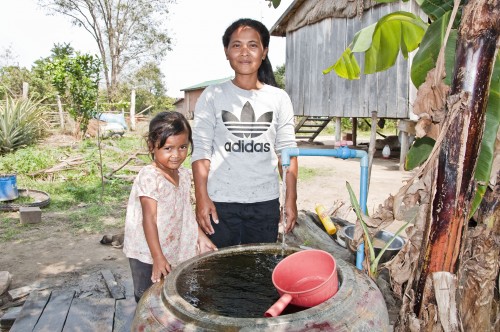IRDEP-PK – Since Ms. Daht Sot moved to live in Rovieng village, Phnom Kravanh district of Pursat province in 2009, her family of four members has used unclean water from wells, stream, lake, or rainwater for her daily needs.
|
|
|
|
|
|
As her husband Soeng Thy, 30, was busy with his job far from home, Sot was responsible for collecting water from the stream or some other water sources for drinking and cooking. Sot, 29, spends two hours for a return trip walking 2 km from her house to the stream. She usually makes one trip in the morning and in late afternoon she and her two daughters, aged 6 and 11 make another trip combining the water collection with a bath and clothe wash at the stream.
To help reduce the difficulties of the villagers, in late 2010 LWD initiated a Water Supply Project. It aimed to respond to the emerging needs of the villagers who are lacking water for their daily household consumption, watering their home gardens, and feeding their ani-mals. The Project, which was completed in February 2011, was designed to catch the water falling from the mountain and store it in concrete reservoir, then let it run through a tube to villagers’ houses.
The success of the pro-ject was highly appreciated by the villagers. Sot, one of 221 families living in the village, said she was very excited when the water was connected into her house. “I never imagine that I have water on tap like this. It’s very easy for my family. When I need water, I just turn on the tap,” she said.
“More specifically, it saved me a lot of time and energy each day,” she said, adding that she did not only have enough water for cooking and drinking, but also for washing clothes. “Previously, I and my daughters took a bath only once day. But, now we do 2 or 3 times per day,” said Sot who became a partner household in 2009.
Her small piece of land which was left idle beside her house for two years now was turned into a vegetable garden. She grew eggplants, Chinese spinach, morning glory and some orange trees. In 2011, besides having enough vegetable to eat, she could earn $10 per month from selling the surplus of her morning glory.
However, the project benefited only 82 families of the total. Those who live higher than the water level and farther than 3 km from the reservoir were unable to access to the water, according to Yim Hoeun, Village Chief and Village Development Committee Leader.
The project cost USD 6,748.55, of which USD 5,639.55 was funded by LWD, USD125 by the commune council, and USD984 was contributed by the community, as well as labor force.
Hoeun said that each user had to pay 2,500 riels ($0.625) per month for water. Those who raise more than 4 pigs had to pay an extra 1,000 riels ($0.25) per month. The money collected from the users is allocated as follows: (i) 25% is given to the Water Management Committee of 7 members as incentives; (ii) 5% for administration expense; (iii) 50% for maintenance; and (iv) 20% for Village Development Fund.



